Exercises (3201)
Bowling
Leakage
Group work
Groups of 4 to 6
The participants roll balls onto ten clubs/turned over marker cones set up in a triangle. How many attempts do the participants need until all the clubs/marker cones have fallen over? In the meantime, the waiting participants perform some relaxation and stretching exercises.
Per group
3 balls
10 clubs / marking cones
Boardball
Stimulate circulation
Group work
2 teams
Two teams play against each other in a limited playing area. A point is scored when a pass via a basketball board (alternative: defined zone on a wall) is caught by a teammate. Bouncing with the ball is not allowed and the number of steps with the ball is limited (e.g. maximum 3 steps)
Optional: change of possession when the ball falls to the ground
2 basketball hoops/walls with a defined target zone
1 ball (e.g. basketball, handball, volleyball, football)
4 marking cones/caps ►court boundary (optional)
x game ribbons/bibs ►team identification
Boardball
Stimulate circulation
Group work
2 teams
Two teams play against each other in a limited playing area. A point is scored when a pass via a basketball board (alternative: defined zone on a wall) is caught by a teammate with the racket.
The following rules apply to the game form:
- The ball, which is balanced on the racket, may be carried a maximum of 4 steps and must then be passed immediately.
- The ball may be touched a maximum of 4 times before it is passed on.
- The ball at rest on the racket, without movement of the player, may be held for a maximum of 4 seconds.
- The ball may not be covered with the racket or body, but must be passed on immediately.
- The ball may not be covered with the racket or the body, but must be played on immediately.
- It is not permitted to actively play the ball with the foot or lower leg, with the hand, the arm or the head (free hit).
- If the ball leaves the playing field, it is put back into play by a free hit by the opposing team at the place of action.
Per participant:
1 racket ►smolball
2 basketball hoops/walls with a defined target zone
1 ball ►smolball
4 marking cones/caps ►court boundary (optional)
x playing ribbons/shims ►team identification
Boardball
Stimulate circulation
Group work
2 teams
Two teams play against each other in a limited playing area. A point is scored when a pass via a basketball board (alternative: defined zone on a wall) is caught by a teammate.
The following rules apply to the game:
- The ball may only be handled with a stick. A player may hold the ball in the basket for a maximum of 5 seconds.
- If a ball lands out of bounds, the player who puts the ball back into play can either run into the court with the ball or play a pass from the sideline (observe the 5-second rule).
- If the ball falls to the floor, players have the option of picking it up with their stick or "covering" it. To cover the ball, cover it with the basket of the stick. After covering the ball with the basket, the opponents must keep a distance of 3 metres and the player with the ball must make a pass (it is not possible to continue running after covering).
- An attack must be executed within 30 seconds.
- Intercrosse is played without contact between body/body and body/stick.
- The player with the ball may only run or stand (star step allowed). Walking is prohibited. When running, the stick must be held in both hands. Catching, throwing or "covering" is permitted with one hand.
- The ball may not be touched with the hand.
Per participant:
1 stick ►intercrosse/lacrosse
2 basketball hoops/walls with a defined target zone
1 ball ►intercrosse/lacrosse
4 marking cones/caps ►court boundary (optional)
x game ribbons/bibs ►team identification
Boardball
Increase pulse
Group work
2 teams
Two teams play against each other in a limited playing area. A point is scored when a pass via a basketball board (alternative: defined zone on a wall) is caught by a teammate. Bouncing with the ball is not allowed and the number of steps with the ball is limited (e.g. maximum 3 steps)
Optional: change of possession when the ball falls to the ground
2 basketball hoops/walls with a defined target zone
1 ball (e.g. basketball, handball, volleyball, football)
4 marking cones/caps ►court boundary (optional)
x game ribbons/bibs ►team identification
Boardball
Increase pulse
Group work
2 teams
Two teams play against each other in a limited playing area. A point is scored when a pass via a basketball board (alternative: defined zone on a wall) is caught by a teammate with the racket.
The following rules apply to the game form:
- The ball, which is balanced on the racket, may be carried a maximum of 4 steps and must then be passed immediately.
- The ball may be touched a maximum of 4 times before it is passed on.
- The ball at rest on the racket, without movement of the player, may be held for a maximum of 4 seconds.
- The ball may not be covered with the racket or body, but must be passed on immediately.
- The ball may not be covered with the racket or the body, but must be played on immediately.
- It is not permitted to actively play the ball with the foot or lower leg, with the hand, the arm or the head (free hit).
- If the ball leaves the playing field, it is put back into play by a free hit by the opposing team at the place of action.
Per participant:
1 racket ►smolball
2 basketball hoops/walls with a defined target zone
1 ball ►smolball
4 marking cones/caps ►court boundary (optional)
x playing ribbons/shims ►team identification
Boardball
Increase pulse
Group work
2 teams
Two teams play against each other in a limited playing area. A point is scored when a pass via a basketball board (alternative: defined zone on a wall) is caught by a teammate.
The following rules apply to the game:
- The ball may only be handled with a stick. A player may hold the ball in the basket for a maximum of 5 seconds.
- If a ball lands out of bounds, the player who puts the ball back into play can either run into the court with the ball or play a pass from the sideline (observe the 5-second rule).
- If the ball falls to the floor, players have the option of picking it up with their stick or "covering" it. To cover the ball, cover it with the basket of the stick. After covering the ball with the basket, the opponents must keep a distance of 3 metres and the player with the ball must make a pass (it is not possible to continue running after covering).
- An attack must be executed within 30 seconds.
- Intercrosse is played without contact between body/body and body/stick.
- The player with the ball may only run or stand (star step allowed). Walking is prohibited. When running, the stick must be held in both hands. Catching, throwing or "covering" is permitted with one hand.
- The ball may not be touched with the hand.
Per participant:
1 stick ►intercrosse/lacrosse
2 basketball hoops/walls with a defined target zone
1 ball ►intercrosse/lacrosse
4 marking cones/caps ►court boundary (optional)
x game ribbons/bibs ►team identification
Board disc
Stimulate circulation
Group work
2 teams
Two teams play against each other in a limited playing area. One point is scored when the Frisbee is thrown at the basketball board (alternative: defined zone on a wall), two points are scored when the Frisbee falls through the basket. It is not allowed to run with the Frisbee and physical contact is prohibited. Opponents must keep an arm's length away from the thrower (passer). If the Frisbee leaves the court or falls to the ground, ownership of the disc changes.
Variant:
In order to prevent uncontrolled (dangerous) long throws, a throwing area can be defined from which throws may be made onto the basketball board (e.g. within the 3-point zone of the basketball court).
2 basketball hoops/walls with a defined target zone
1 throwing disc (frisbee) ► Frisbee Ultimate
4 marking cones/caps ►court boundary (optional)
x game ribbons/bibs ►team identification
Letter relay
Increase pulse
Group work
4-5 participants per group
There are numerous letter tokens (letters face down) at the turning point, which are available to all groups. The runners each pick up a token (it is not possible to swap) and bring it to the group. If there are no more tokens available or after a time limit set by the sports leader, the groups have 2 minutes to form (correct) words. Each letter used for a word is worth one point. Which group scores the most points?
Variant:
Which group is the first to have all the necessary letters to form a word defined by the sports instructor? In this variant, the token is looked at at the reversal point, if it can be used, it is taken to the group. If the letter cannot be used (already present in the solution word), the token is left behind and the group returns to the group without a new letter before sending the next runner off to the tokens with a handshake.
Stopwatch
x letters/tokens
Burgball
Stimulate circulation
Group work
6-10 participants per group
One team in possession of the ball forms a circle around a Swedish box. The other team stands in the circle and tries to prevent the box from being hit with the ball. After each hit or catch of the ball by the defenders, the roles of the teams are swapped (if necessary, also swap if the ball is missed or dropped).
Variant:
Place a gym ball on the vaulting box, which must be hit.
1 vaulting box
1 ball (e.g. foam/softball or handball) ►handball
1 exercise ball ►variant
Choreo
Mobilisation of the joints / dynamic stretching
Group work
To the beat of the music, one participant demonstrates a mobilisation exercise for the joints or a dynamic stretching exercise (functional gymnastics with rocking movements). The whole group then performs the exercise together. The next participant (in the group or determined by the sports leader) demonstrates a new exercise. The exercises are combined using the add-on method (exercise 1, then exercise 2, then exercise 1+2 together, etc.). Any number of exercises can be combined to form a small choreography.
1 music system incl. music (various)
Crane Jump
Parkour
Individual work
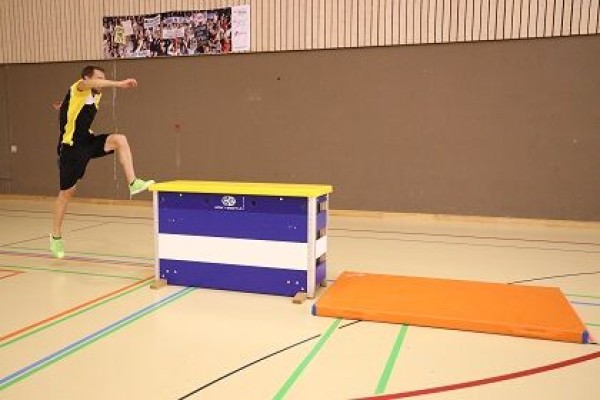
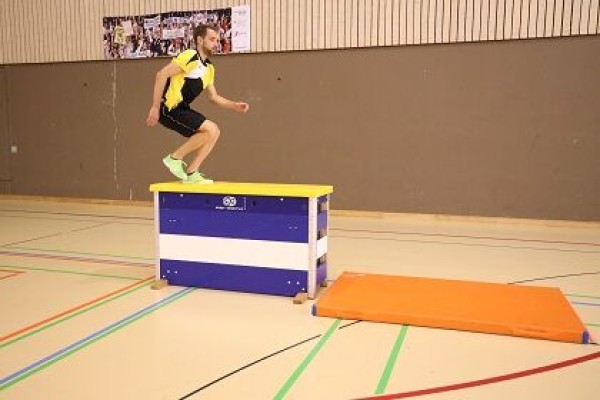
Short run-up to the vaulting box (obstacle - e.g. wall ► outdoor variant), one-legged jump from the run, landing with the other foot on the box (step jump).
Variant:
Place a lower vaulting box in front of the vaulting box (2-3 elements) and jump in a step jump first onto the small box and then onto the large box.
1 vaulting box ►indoor version
1 soft mat (small) ►indoor version
2-3 vaulting box elements incl. top section ►variation of the exercise
Indoor set-up:
Place a soft mat behind a vaulting box.
Variation: Place a lower box in front of the vaulting box.
outdoor:
A raised obstacle (wall or similar).
Endurance run
Basic training
Group work
In (small) groups according to running speed or individually
An endurance run in (small) groups (based on running speed) or individually on a flat course. The running speed remains constant the whole time (choose the appropriate speed depending on the strength class).
Course: loop; from A to B; from A to B and back again
Intensity level: 2-3 (easy-medium)
Hmax: 70-90%
Rule of speech: chatting - speaking in full sentences
Attention:
The course must be known or clearly signalled to all participants.
Variant:
Change the course of the route (e.g. integrate inclines).
Signalling (e.g. route tape)
Evaluation FTA (group formation)
Participant:
1 heart rate monitor
Endurance run with increased intensity
Basic training
Group work
In (small) groups according to running speed or individually
An endurance run in (small) groups (based on running speed) on a flat course. The running speed is increased from time to time (choose the appropriate pace depending on the strength class), but the specified intensity levels are maintained.
Course: loop; from A to B; from A to B and back again
Intensity level: 1-3 (very easy-loose-medium)
Hmax: 60-90%
Speaking rule: sing-chatter-speak in full sentences
Caution:
The course must be known or clearly signalled to all participants.
Variant:
Change the course (e.g. integrate inclines).
Signalling (e.g. route tape)
Evaluation FTA (group formation)
Participant:
1 heart rate monitor
Daumenjudo
Fighting and roughhousing games
Partner work

Two participants hold hands crosswise with their thumbs in the air. On command, both try to catch the opponent's thumb with their own thumb and press it down. The winner is the one who can hold their opponent's thumb for two seconds. Switch sides after each round.
No material required
Cover work
Light-Contact
Individual work
From the shoulder-width boxing position, a tennis ball is bounced with one hand while the other hand is always held at the temple. The participant moves freely on their feet as if on a track (forwards, backwards, sideways - also in a circle, bouncing the tennis ball at the same point).
Variant:
A fight between everyone (or duel): the participant whose tennis ball touches the floor or is held twice in succession completes an additional task (press-ups, stretch jumps, squats). The opponent's tennis ball may be touched, but there is no physical contact.
1 Tennisball
Cover work
Light-Contact
Group work


Exercise 1:
Static form: From the shoulder-width boxing position, bounce a tennis ball (in a hoop) with one hand, keeping the other hand on your temple at all times. Change which hand is bouncing the tennis ball from time to time.
Exercise 2:
Dynamic form: Move the tennis ball between the rings (bouncing on the feet) without touching them.
Exercise 3:
On a command from the instructor ("top"), swap the tennis ball with a partner.
Exercise 4:
At the instructor's command ("top"), try to steal another participant's tennis ball without losing your own ball.
Exercise 5:
All against all (elimination match): whoever loses their ball is eliminated (possibly perform additional tasks).
Per participant:
1 tennis ball
1 tyre
Diagonal stand
Coordination exercises
Individual work
Place one foot and the opposite hand on the slackline, stretch out the other limbs (horizontally) and hold the position. The closer the hand and foot are to each other, the less stable the position is; if they are further apart, you need good body tension.
Elevate:
Tap marked points on the ground with your hand; cat walk (move forwards from a diagonal position).
1 Slackline
Thief jump I
Parkour
Individual work
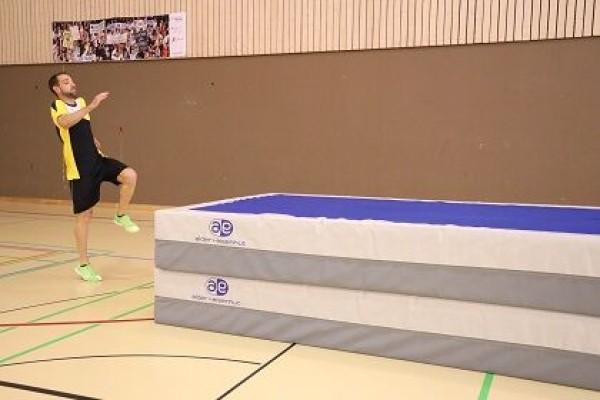

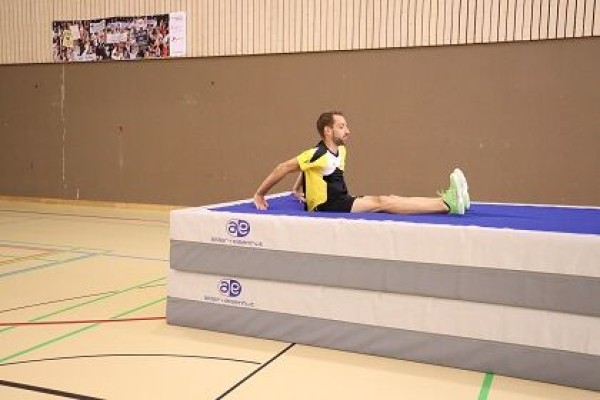
Strong run-up, frontal take-off approx. one leg length in front of two soft mats lying on top of each other, pull your legs up quickly in the air and bring them forwards in a horizontal position, hit the mat hard with both hands when landing in the seat.
Variant:
Lower mat height (only 1 soft mat).
2 soft mats (large)
Post structure:
Place two large soft mats on top of each other.
Thief jump II
Parkour
Individual work
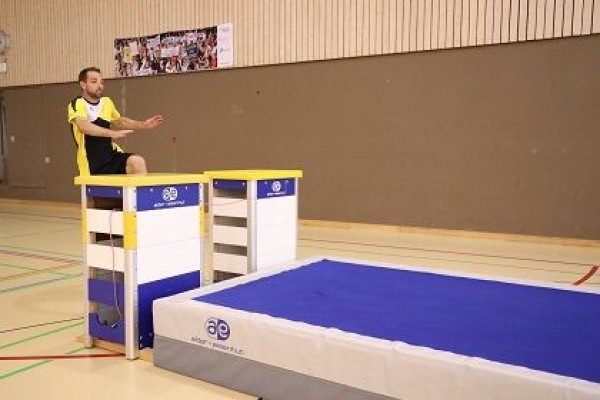

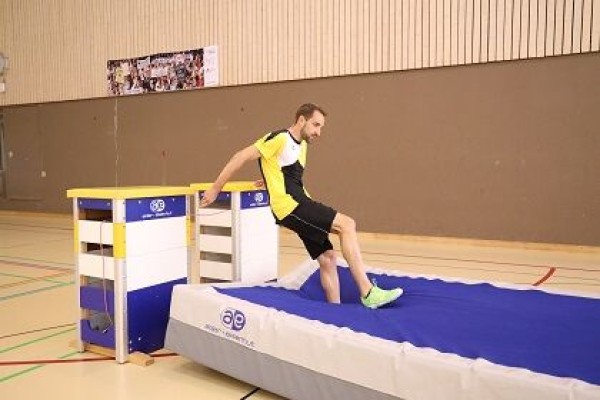
Strong run-up, frontal take-off approx. one leg length in front of the obstacles, pull your legs up quickly and bring them forwards in a horizontal position, push off the vaulting box with both hands.
Variant:
Vary the height of the box.
2 vaulting boxes/pommel horses
1 soft mat (large)
1 elastic rubber band
Post set-up:
Place two vaulting boxes next to each other at a distance of approx. 50 cm, place a large soft mat behind them, stretch an elastic rubber band between the vaulting boxes if necessary
Thief jump III
Parkour
Individual work
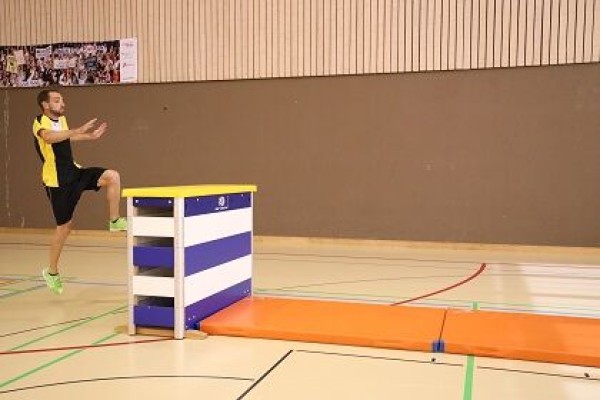
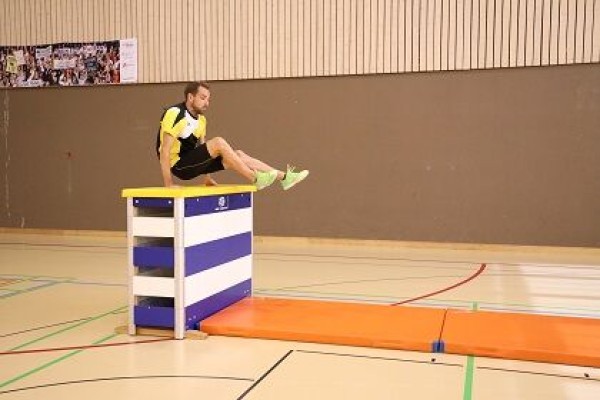

Strong run-up, frontal take-off approx. one leg length in front of the vaulting box, pull your legs up quickly and bring them forwards horizontally, push off the box forcefully with both hands to land, continue running directly after landing.
Variant:
Vary the height of the box.
1 Swedish box/pommel horse
Distance fitting
Stimulate circulation
Partner work
The binomial lines up on a line. Using passes, the pair must reach a defined target zone. One participant in the group moves away in the direction of the target. They decide for themselves how far they want to distance themselves from their partner. At the new position, they must be able to catch/receive the Frisbee/ball thrown/passed by their partner. If this is successful, the thrower may now approach the target and at the same time becomes the new pass receiver. If the pass attempt is unsuccessful, the frisbee/ball must be returned to the thrower by the catcher so that the thrower can start a new pass attempt (possibly at a shorter distance).
Variant:
Multiple groups of 2 compete against each other. The winning binomial is the one that is the first to return to the starting line after the start command from the sports director in compliance with the rules described above.
Per participant:
1 bat/stick ►intercross/lacrosse, smolball
Per group of 2:
1 throwing disc (frisbee)/ball ►frisbee ultimate, basketball, FooBaSKILL, handball, intercross/lacrosse, smolball
4 marking cones/caps ►start and finish line
Distance collector
Coordination exercises
Individual work
The participants form two groups, each of which is assigned to a slackline. Now the participants, one after the other, walk as far as possible along the slackline. The distances travelled by the individual participants are added up. Which group covers a greater distance
Difficulty:
Only metres walked backwards count
1 Slackline
Double passing game
Coordination exercises
Partner work
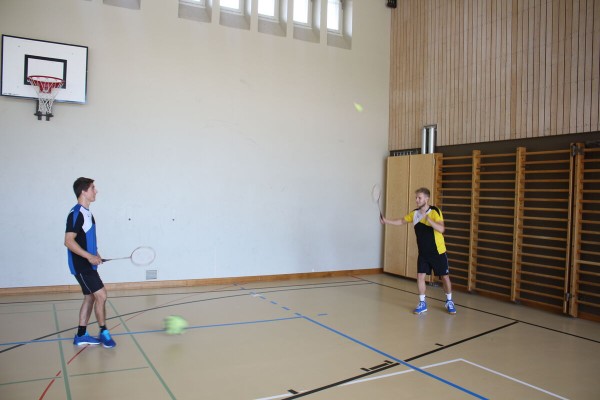
Two participants stand opposite each other at a distance of 3-5 metres and simultaneously pass a football and a shuttle back and forth with badminton rackets.
Variant:
Pass the football and shuttle at the same or opposite pace.
► Differentiation skills, orientation skills, reaction skills
Per group of 2:
2 badminton rackets
1 badminton shuttle
1 football
Swivel squat I
Parkour
Individual work



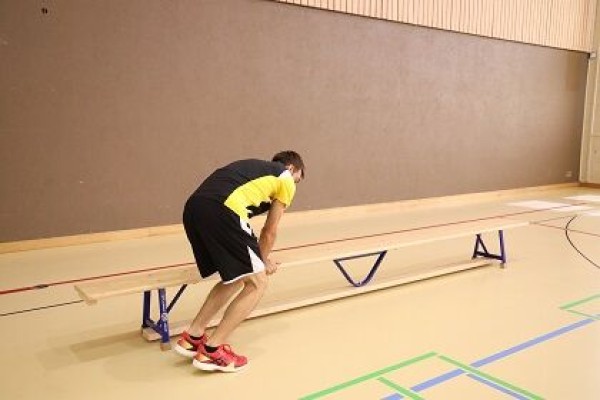
Stand on one side of the long bench, hold on to the edges of the wide side of the long bench with your hands, jump over the bench in as high a squat as possible (squat turn), land on the other side of the long bench.
Variant:
Place balls on the long bench, over which the legs must be guided.
1 long bench
2-3 medicine balls ► Variation of the exercise